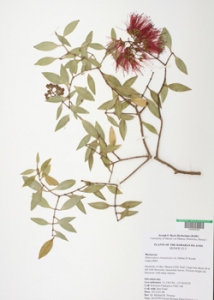
A University of Hawaiʻi at Mānoa project to digitize tens of thousands of plant specimens from Hawaiʻi, across the vast Pacific Ocean and around the world, received a major boost by the National Science Foundation. The three-year, $148,882 grant will help School of Life Sciences Assistant Professor Karolina Heyduk and her team to digitize and catalog more than 55,000 plant specimens, many of which are extinct, to preserve and improve access worldwide to one of the oldest collections of Pacific plants.

“Our goal for the project is to get all 55,000 plant specimens digitized for the whole world to see and facilitate research on Hawaiian plants across the globe,” Heyduk said. “The herbarium represents a really unique collection that is used by both researchers and also used in classes and teaching on campus.”
Hawaiʻi has some of the greatest biodiversity in the world and there are approximately 1,400 plant taxa (species, subspecies and varieties) native to the state, according to the Hawaiʻi Department of Land and Natural Resources. Nearly 90% are found nowhere else in the world. However, more than 100 plant taxa have gone extinct, and more than 200 have 50 or fewer individuals remaining in the wild.

UH Mānoa’s Joseph F. Rock Herbarium was established in 1908 and is home to many rare and endemic plant specimens from Hawaiʻi and other Pacific islands, some of which have since become extinct. The herbarium serves as a crucial record of biodiversity and is an invaluable resource for species that are extinct, threatened or endangered.
The UH Mānoa collection will join other herbaria from around the world, which have digitized their collections and made them available through a dedicated Consortium of Pacific Herbaria web portal and iDigBio.org.
Heyduk plans to employ nearly 10 students each year for the next three years to work on the digitization project, emphasizing education for students from historically-excluded groups, including Native Hawaiians and Pacific Islanders. The herbarium staff plans to host volunteer digitization events, increase collaboration with UH Mānoa’s campus arboretum and UH Mānoa’s Lyon Arboretum, engage with the public through events at local botanical gardens, and continue efforts to connect the herbarium to Hawaiian culture and knowledge.
Learning through the herbarium

Chase Kane, a junior biochemistry major, is one of the students working on the project. Kane said one of the biggest lessons he has learned through working in the herbarium is discovering how important Native Hawaiian flora are, particularly with native ecosystems. Kane hopes to attend medical school, and said his work in the herbarium has sparked his interest in the medicinal properties of plants.
“I have a much better understanding about the medicinal effects of a lot of native Hawaiian and Pacific plants and flowers,” Kane said. “They’re just really important in the past for healing and medicine, and I think it’s something we should be thinking about going forward in modern medicine.”

G Young Kim, a master’s student in botany, earned her bachelor’s degree in botany in 2021 and is also working on the digitization project. She is most looking forward to seeing how her work will help researchers from around the world to access the collection without having to travel.
“The herbarium has mostly Native Hawaiian specimens and that will help researchers assess and learn more about plants from the Hawaiian archipelago without having to come here,” Kim said. “That will be really valuable in the scientific world.”
To support the Joseph F. Rock Herbarium, visit the UH Foundation website.
—By Marc Arakaki

